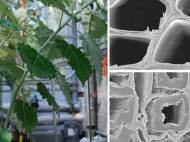Tension wood study could lead to more effective biofuel production
 Tension wood, which forms naturally in hardwood trees as a response to bending stress, is known to possess unique features that make it desirable as a bioenergy feedstock. Researchers at the Department of Energy’s BioEnergy Science Center (BESC) have studied that phenomenon in trees which could lead to development of new crops capable to produce more biofuel.
Tension wood, which forms naturally in hardwood trees as a response to bending stress, is known to possess unique features that make it desirable as a bioenergy feedstock. Researchers at the Department of Energy’s BioEnergy Science Center (BESC) have studied that phenomenon in trees which could lead to development of new crops capable to produce more biofuel.
Although individual elements of tension wood have been previously studied, the BESC team is the first to use a comprehensive suite of techniques to systematically characterize tension wood and link the wood’s properties to sugar release.
They found that tension wood properties have an increased number of woody cells, thicker cell walls, more crystalline forms of cellulose and lower lignin levels. All of the mentioned properties are desired in biofuel crop since plant sugars, known as cellulose, are fermented into alcohol for use as biofuel.
“Tension wood in poplar trees has a special type of cell wall that is of interest because it is composed of more than 90 percent cellulose, whereas wood is normally composed of 40 to 55 percent cellulose”, said Oak Ridge National Laboratory’s Udaya Kalluri, BESC Science Coordinator and co-author on the study. “If you increase the cellulose in your feedstock material, then you can potentially extract more sugars as the quality of the wood has changed. Our study confirms this phenomenon.”
The research also provides a new insight into recalcitrance – the natural plant barriers that prevent the release of sugars necessary for biofuel production.
“Recalcitrance of plants is ultimately a reflection of a series of integrated plant cell walls, components, structures and how they are put together”, said co-author Arthur Ragauskas of Georgia Institute of Technology. “This paper illustrates that you need to use an holistic, integrated approach to study the totality of recalcitrance.”
Using the current study as a model, the researchers are extending their investigation of tension wood down to the molecular level and hope to eventually unearth the genetic basis behind its desirable physical features. Although tension wood itself is not considered to be a viable feedstock option, insight gleaned from studying its unique physical and molecular characteristics could be used to design and select more suitably tailored bioenergy crops.
“This study exemplifies how the integrated model of BESC can bring together such unique research expertise”, said BESC director Paul Gilna. “The experimental design in itself is reflective of the multidisciplinary nature of a DOE Bioenergy Research Center.”
For more information, read the paper published in Energy & Environmental Science named: “Chemical, ultrastructural and supramolecular analysis of tension wood in Populus tremula x alba as a model substrate for reduced recalcitrance”.









Leave your response!